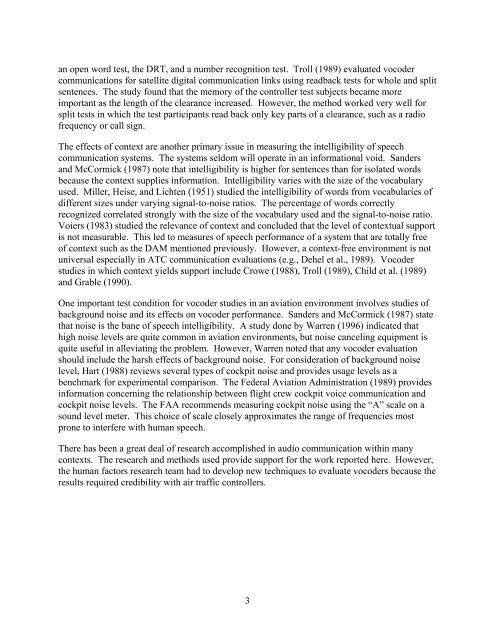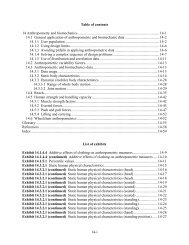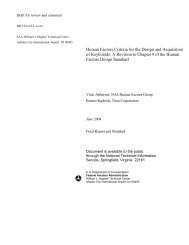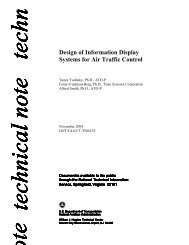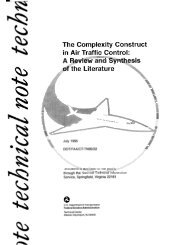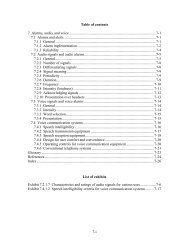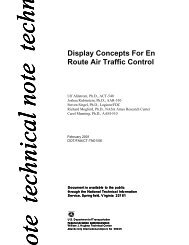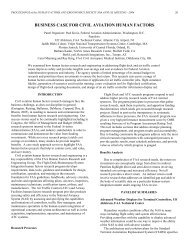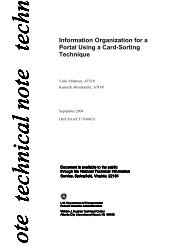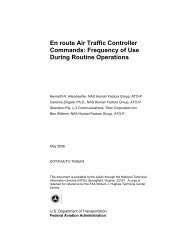Human Factors Evaluation of Vocoders for Air Traffic Control ... - FAA
Human Factors Evaluation of Vocoders for Air Traffic Control ... - FAA
Human Factors Evaluation of Vocoders for Air Traffic Control ... - FAA
Create successful ePaper yourself
Turn your PDF publications into a flip-book with our unique Google optimized e-Paper software.
an open word test, the DRT, and a number recognition test. Troll (1989) evaluated vocoder<br />
communications <strong>for</strong> satellite digital communication links using readback tests <strong>for</strong> whole and split<br />
sentences. The study found that the memory <strong>of</strong> the controller test subjects became more<br />
important as the length <strong>of</strong> the clearance increased. However, the method worked very well <strong>for</strong><br />
split tests in which the test participants read back only key parts <strong>of</strong> a clearance, such as a radio<br />
frequency or call sign.<br />
The effects <strong>of</strong> context are another primary issue in measuring the intelligibility <strong>of</strong> speech<br />
communication systems. The systems seldom will operate in an in<strong>for</strong>mational void. Sanders<br />
and McCormick (1987) note that intelligibility is higher <strong>for</strong> sentences than <strong>for</strong> isolated words<br />
because the context supplies in<strong>for</strong>mation. Intelligibility varies with the size <strong>of</strong> the vocabulary<br />
used. Miller, Heise, and Lichten (1951) studied the intelligibility <strong>of</strong> words from vocabularies <strong>of</strong><br />
different sizes under varying signal-to-noise ratios. The percentage <strong>of</strong> words correctly<br />
recognized correlated strongly with the size <strong>of</strong> the vocabulary used and the signal-to-noise ratio.<br />
Voiers (1983) studied the relevance <strong>of</strong> context and concluded that the level <strong>of</strong> contextual support<br />
is not measurable. This led to measures <strong>of</strong> speech per<strong>for</strong>mance <strong>of</strong> a system that are totally free<br />
<strong>of</strong> context such as the DAM mentioned previously. However, a context-free environment is not<br />
universal especially in ATC communication evaluations (e.g., Dehel et al., 1989). Vocoder<br />
studies in which context yields support include Crowe (1988), Troll (1989), Child et al. (1989)<br />
and Grable (1990).<br />
One important test condition <strong>for</strong> vocoder studies in an aviation environment involves studies <strong>of</strong><br />
background noise and its effects on vocoder per<strong>for</strong>mance. Sanders and McCormick (1987) state<br />
that noise is the bane <strong>of</strong> speech intelligibility. A study done by Warren (1996) indicated that<br />
high noise levels are quite common in aviation environments, but noise canceling equipment is<br />
quite useful in alleviating the problem. However, Warren noted that any vocoder evaluation<br />
should include the harsh effects <strong>of</strong> background noise. For consideration <strong>of</strong> background noise<br />
level, Hart (1988) reviews several types <strong>of</strong> cockpit noise and provides usage levels as a<br />
benchmark <strong>for</strong> experimental comparison. The Federal Aviation Administration (1989) provides<br />
in<strong>for</strong>mation concerning the relationship between flight crew cockpit voice communication and<br />
cockpit noise levels. The <strong>FAA</strong> recommends measuring cockpit noise using the “A” scale on a<br />
sound level meter. This choice <strong>of</strong> scale closely approximates the range <strong>of</strong> frequencies most<br />
prone to interfere with human speech.<br />
There has been a great deal <strong>of</strong> research accomplished in audio communication within many<br />
contexts. The research and methods used provide support <strong>for</strong> the work reported here. However,<br />
the human factors research team had to develop new techniques to evaluate vocoders because the<br />
results required credibility with air traffic controllers.<br />
3


